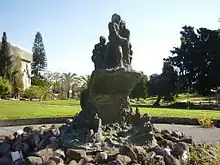Netzer Sereni
Netzer Sereni (Hebrew: נֵצֶר סֶרֶנִי) is a kibbutz in central Israel. Located in the Shephelah between Be'er Ya'akov and Ness Ziona, it falls under the jurisdiction of Gezer Regional Council. In 2021 it had a population of 945.[1]
Netzer Sereni
נֵצֶר סֶרֶנִי نيتسر سرني | |
|---|---|
 Havat Allenby | |
 Netzer Sereni | |
| Coordinates: 31°55′21″N 34°49′20″E | |
| Country | Israel |
| District | Central |
| Council | Gezer |
| Affiliation | Kibbutz Movement |
| Founded | 20 June 1948 |
| Founded by | Holocaust survivors |
| Population (2021)[1] | 945 |
History

Kibbutz Netzer Sereni was founded in 1948 by Holocaust survivors liberated from Buchenwald concentration camp, who had established themselves in 1945 as the "Kibbutz Buchenwald", an agricultural collective designed to prepare Jews for life in Palestine - the first such Hakhshara group established in Germany after the war.[2][3][4][5] The kibbutz was established on the land of the depopulated Palestinian village named Bir Salim.[6][7] The name was changed later to Netzer by the Buchenwald members. The kibbutz was named Netzer Sereni after Enzo Sereni, a Jewish Italian intellectual, Zionist leader and Jewish Brigade officer. Sereni was one of the founders of Givat Brenner. He was parachuted into Nazi-occupied Italy in World War II, only to be immediately captured by the Germans and executed in Dachau concentration camp;[8] in Hebrew netzer means sprout, shoot or branch.
In 1948–1951 a national political separation between the two labour parties, Mapam and Mapai, led to a split within the kibbutz movement.[9][10] In 1952, 120 Mapai members of Kibbutz Givat Brenner broke away for ideological reasons and moved to Netzer Sereni.[8]
Notable people
References
- "Regional Statistics". Israel Central Bureau of Statistics. Retrieved 22 February 2023.
- Judith Tydor Baumel, Kibbutz Buchenwald: Survivors And Pioneers, Rutgers University Press, 1997, ISBN 9780813523378
- Erhard Roy Wiehn (ed.), Wer hätte das geglaubt, Hartung-Gorre Verlag, 2010, Konstanz
- November 12, 1945, The dining room of Kibbutz Buchenwald, Germany, Yad Vashem website
- March 1946, Members of the “Kibbutz Buchenwald” Pioneer Training Group in Antwerp, Belgium, Yad Vashem website
- Morris, Benny (2004). The Birth of the Palestinian Refugee Problem Revisited. Cambridge University Press. p. xx, settlement #11. ISBN 978-0-521-00967-6.
- Khalidi, Walid (1992). All That Remains: The Palestinian Villages Occupied and Depopulated by Israel in 1948. Washington D.C.: Institute for Palestine Studies. p. 371. ISBN 0-88728-224-5.
- Daniel Gavron (2000) The Kibbutz: Awakening from Utopia Rowman & Littlefield, p59
- Kibbutz Movement in Israel Splits; Mapai Delegates Walk out of Mapam-Dominated Parley. Jewish Telegraphic Agency, May 23, 1951
- Marcia Drezon-Tepler (1990). Interest Groups and Political Change in Israel. State University of New York Press (SUNY Press). p. 104. ISBN 978-0-7914-0207-8. Retrieved 26 June 2018.